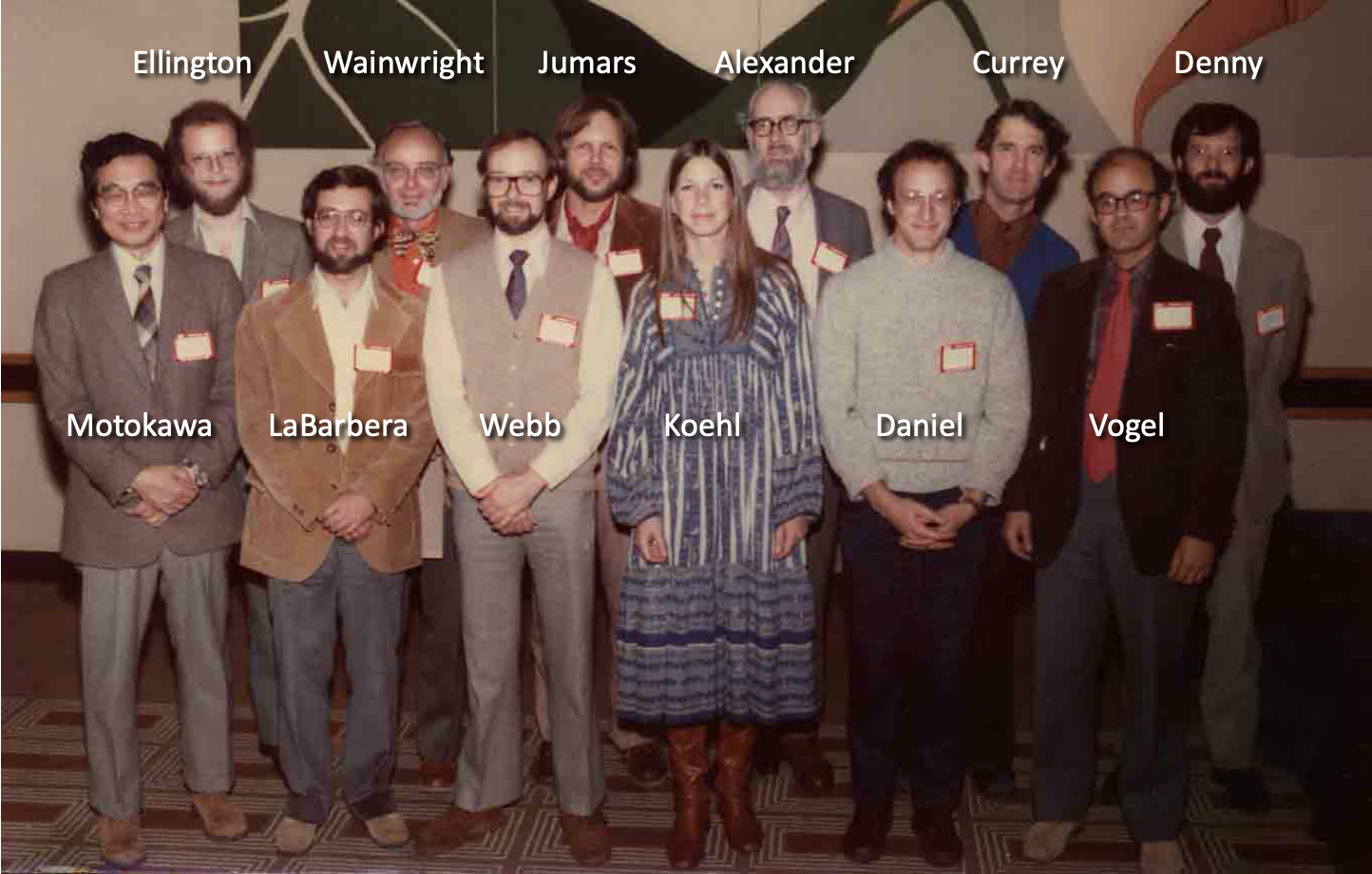Division Information
About DCB:
Members of the Division of Comparative Biomechanics (DCB) are interested in the physical principles that govern how organisms function and, in turn, how their functional systems have been, and are, evolving. This inherently multidisciplinary field integrates ideas and techniques from engineering, physiology, animal behavior, neurobiology, computational science, robotics, ecology, and evolutionary biology. Our methods are just as varied: we work in the lab and the field to engage with organisms in experiments and through observations; we design and build new types of instruments to measure motions, movements, and forces across scales of size and levels of structural hierarchy; and we create mathematical, computational, and robotic models to test and formalize our understanding of how organisms function and evolve.
What makes this exciting multidisciplinary research in Comparative Biomechanics work is the collaboration of individuals with diverse backgrounds and interests. Supporting collaboration — no matter who you are or where you are in your career — is the primary function of DCB.
You can start or enhance your collaborations by becoming a member of DCB and joining us for regional and annual meetings. If you are already a member, then join us in supporting members through the transitions of their own career arcs by serving DCB directly as a member of one of our committees or standing for an elected position. At meetings, help us foster collaboration by giving a talk or poster, attending talks and posters, and meeting new colleagues at social events. A great way to build supportive collaboration is to create your own team to propose a symposium, work which involves selecting speakers, writing a brief proposal, conducting the symposium, and then helping get your speakers published through a peer-review process at our journal made for symposiums, Integrative and Comparative Biology. While DCB promotes work on organisms of all phylogenetic affiliations, a strong intersection of DCB and DVM members has led to a vigorous collaboration between these divisions and their members. We encourage collaborations and affiliations with any and all divisions within SICB.

The origin story for Comparative Biomechanics at SICB begins in 1984, when the first Biomechanics session was held. The session featured many of the field’s founders and their students and colleagues: McNeil Alexander, John Currey, Tom Daniel, Mark Denny, Charlie Ellingtson, Mike LaBarbera, Mimi Koehl, Peter Jumars, Tatsuo Motokawa, Steve Vogel, Steve Wainwright, and Paul Webb. As biomechanics sessions became a regular part of the annual meeting ecosystem, a new division was created in 2007, with Bob Full taking the helm as the Division’s first chair. DCB has grown to be a vigorous part of the SICB ecosystem, with nearly 1000 members, students, postdoctoral researchers, senior researchers, and faculty members from Australia, Belgium, Brazil, Canada, China, France, Germany, Ireland, Israel, Japan, Netherlands, Spain, Sweden, Switzerland, Turkey, the United Kingdom, and the United States.
DCB Officers
| Chair | Misty Paig-Tran | 2025-2027 |
| Chair-Elect | Jake Socha | 2025-2027 |
| Past Chair | Brooke Flammang | 2025-2027 |
| Secretary | Cassandra Donatelli | 2024-2026 |
| Program Officer | Glenna Clifton | 2024-2026 |
| Student/Postdoc Representative | Andrew Schulz | 2023-2026 |
DCB Bylaws
View DCB bylaws here
Divisional Members Meeting Minutes
Minutes of past divisional Members Meetings are available here. Members Meetings occur each year in association with the annual society-wide conference in January.
News & Announcements
Spring 2021 Newsletter
Click here to see the divisional news from Spring 2021!
International Meetings
The 9th World Congress of Biomechanics will be held in Taipei, Taiwan, in July 2022. More information can be found here.
Workshops
The Mathematical Laws of Morphology and Biomechanics
Alessandro Maria Selvitella (Department of Mathematical Sciences, Purdue University Fort Wayne) and Kathleen Lois Foster (Department of Biology, Ball State University) are running a seminar series and working groups on the theme of ‘The Mathematical Laws of Morphology and Biomechanics’, in partnership with the NSF-Simons Center for Quantitative Biology at Northwestern University and the eScience Institute – University of Washington.
Seminars
Alain Goriely from the University of Oxford gave the first presentation in the seminar series on ‘Ten Ways to Model Growth’. This talk, as well as recordings of future seminars and working groups, will appear on the Mathematical Laws of Morphology and Biomechanics YouTube Playlist. Check out the seminar page on the website for the upcoming talks.
Working Groups
Each term, working groups will concentrate on a specific topic, starting in Fall 2021 with Animal Locomotion and discussions based on Gordon et al.’s Animal Locomotion: Physical Principles and Adaptations (2017). The goal of the working groups is to form productive collaborations on projects that benefit from cross-disciplinary interactions. As part of working group meetings, participants will be encouraged to give short presentations on concrete problems (perhaps side-projects or problems that have been set aside due to a need for complementary expertise). These problems could come from biomechanics or morphology and might benefit from advanced mathematical or computational tools.
For more information about the seminars and working groups or to find out how to get involved, email the organizers (klfoster@bsu.edu or aselvite@pfw.edu), check out the website, or join the conversation on the MaLaMoBi Slack Channel.
Awards
The Carl Gans Award
The Carl Gans Award is named in recognition of Carl Gans’ scientific career and editorial contributions to animal morphology, biomechanics, and functional biology.
For complete details and nominations please see the instructions linked here.
The Steven Vogel Award for the Best Student Poster in Biomechanics
The Mimi A. R. Koehl and Stephen A. Wainwright Award for the Best Student Talk in Biomechanics
Students interested in being considered for these awards should refer to the SICB BSP application guidelines page linked here.
Career and Resources
SICB’s job board can be found here.
[custom-twitter-feeds screenname=”SICB_DCB_DVM” num=9]

